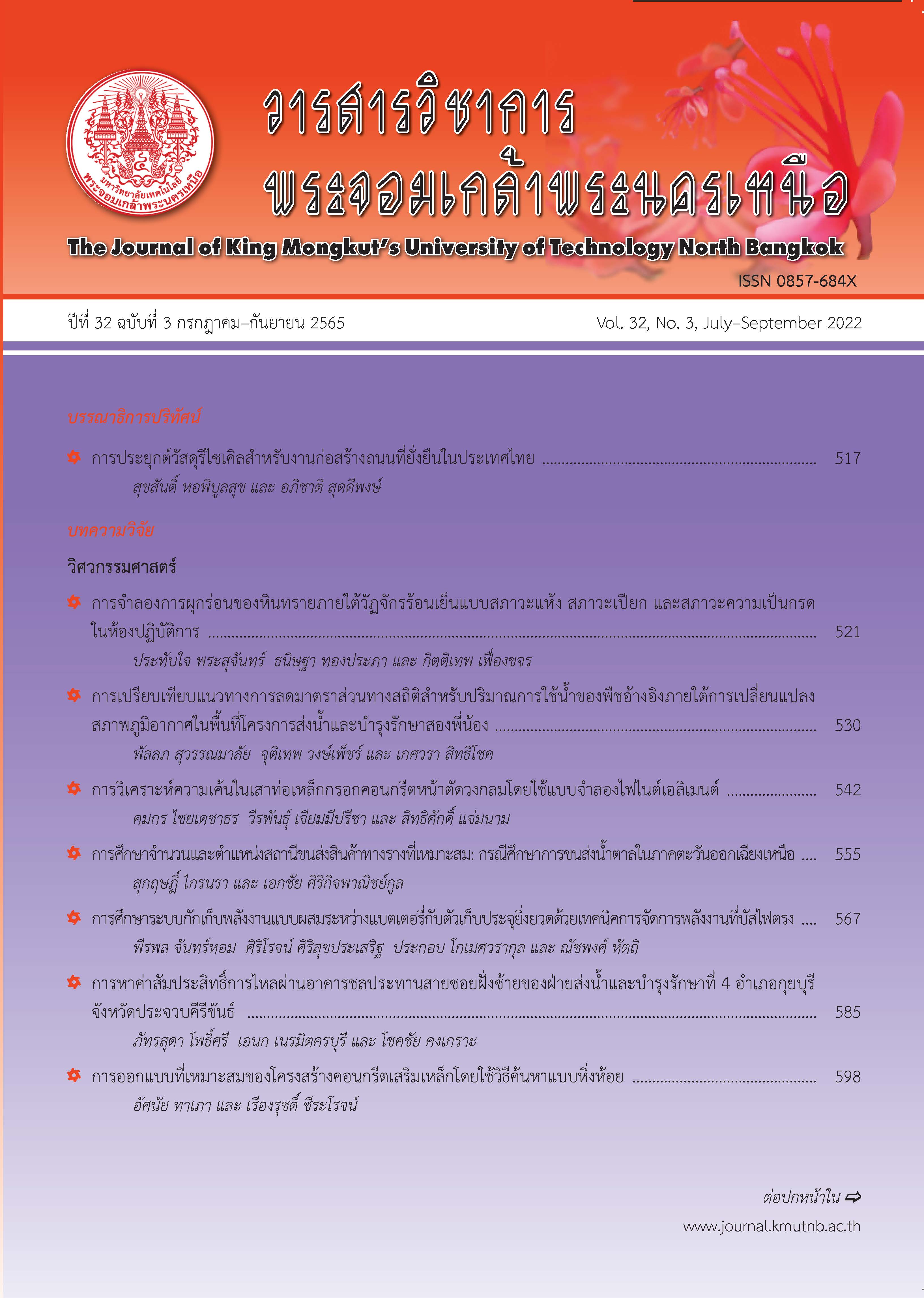Optimum factors between carburizing Temperature and Time in Hardening Big Knife by Pack Carburizing Process Using Periwinkle Shells as an Energizer
Main Article Content
Abstract
The objective of this research was to study the optimum factors between carburizing temperature and time affecting the mechanical properties of hardened big knives hardened by carburizing process using periwinkle shells as an energizer. The mechanical properties which consisted of hardness and impact values were studied. These properties from the experiment were used for comparison with the mechanical property values delivered from the knife forging community, whereby the average hardness value was 607.0 HV and the average impact value was 14.0 Joules. The experiment was conducted by forging big knives from low carbon steel with the similar shape and size as those fabricated by the knife-forging community. The pack carburizing compound consisted of 80% eucalyptus wood charcoal powder as carburizer and 20% periwinkle shells powder by weight as energizer. The principle of design of experiment (DOE) was used to design the experiment and the optimization was statistically analyzed. The two optimized factors in this study consisted of carburizing temperature and carburizing time. The carburizing temperature consisted of three levels i.e. 960, 980 and 1,000 degree Celsius. The carburizing time consisted of three levels i.e. 60, 90 and 120 minutes. The experimental steps were as follows; the knives were carburized then austenitized at 780 degrees Celsius for 15 minutes and quenched in water. After that, the knives were tempered at 180 degree Celsius for 60 minutes. The analyzed results showed that the optimum carburizing temperature was 1,000 degrees Celsius and the optimum carburizing time was 96.1 minutes. The two factors provided the average hardness of 606.9 HV and the average impact value of 24.8 Joules. The optimum values of carburizing temperature and time were verified. The verification results revealed average hardness of 610.2 HV and the average impact value of 21.6 Joules, which coincided with the scope of the mechanical properties of forged and hardened knives from the fabricated community.
Article Details

This work is licensed under a Creative Commons Attribution-NonCommercial-NoDerivatives 4.0 International License.
The articles published are the opinion of the author only. The author is responsible for any legal consequences. That may arise from that article.
References
M. Sathirajinda, Iron & Steel Heat Treatment Engineering. Bangkok : The Engineering Institute of Thailand under His Majesty the King’s Patronage, 1995 (in Thai).
P. Pitsuwan, P. Suwan, Y. Sengty, and P. Kongsong, “Influence of catalyst on surface hardening of low carbon steel by pack carburizing with mangrove charcoal powder,” Journal of Industral Technology Ubon Ratchathani Rajabhat University, vol. 8, no. 2, pp.1–12, 2018 (in Thai).
M. R. Oyawoye, O. R. Momoh, and Y. M. Sani, “Kinetic studies of thermal decomposition of periwinkle shell,” Nigerian Research Journals of Engineering and Environmental Sciences, vol. 4, no. 2, pp. 702–708, 2019.
B. H. Setiamarga and U. Rumendi. “Comparison of the effectiveness of pack carburization energizers for surface hardening of low carbon steel,” in Proceedings The 2nd AUN/SEED-Net Regional Conference on Materials Engineering: Material for Changing World. Burapha University, Thailand, 2009, pp. 107–110.
D C. Montgomery, Design and Analysis of Experiments. John Wiley & Sons Inc, 2009.
S. Srinork, N. Thammachot, J. Nithikarnjanatharn, R. Duekunthod, S. Noyming, C. Peeratatsuwan, and A. Mayai, “The optimization parameters in pack carburizing process by using lime stone powder as energizer for hardening the sugarcane cutting knife,” in Proceedings Industrial Engineering Network Conference Local Industrial Innovations for Global Community, 2016, pp. 1205–1210 (in Thai) .
S. Srisuk, N. Thammachot, J. Banthao, J. Nithikarnjanatharn, W. Homjabok, A. Mayai, and S. Noyming, “A study of the relation of temperature and time effected on the big knives hardening in pack carburizing process by using calcium carbonate,” in Proceedings Operations Research, 2019, pp. 202–207 (in Thai).
D. R. Askeland and P. P. Phule, The Science and Engineering of Materials. Brooks/Cole, Thomson Learning, Inc, 2003.
H. S. Avner, Introduction to Physical Metallurgy, 2nd ed. Singapore: McGrall-Hill, Inc., 1974.
W. F. Smith, Principle of Materials Science and Engineering, 3rd ed. McGrall-Hill, Inc. 1996.
W. Homjabok, N. Thammachot and N. Thadee, “The comparison of catalyst between the egg shell and CaCO3 in the pack carburizing process,” Research Journals Eastern Rajamangala University of Technology, vol. 8, no. 1, pp. 29–36, 2015 (in Thai).

